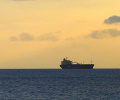

The Piraeus Port, located 12 kilometers southwest of Greece’s capital Athens, is frequently mentioned in meetings between Chinese and Greek leaders. In the Greek language, Piraeus means “choke-point on the passage.” Bordering the Mediterranean Sea on the south and the Balkan Peninsula on the north, it is one of the closest Mediterranean ports on the European continent to the Suez Canal-Gibraltar main shipping routes and has railway connection to the hinterland of Central and Eastern Europe. Its strategic location makes it a key port of the Mediterranean.
Over a decade ago however, Greece was hit hard by the European debt crisis. Piraeus was struggling to stay afloat, with only 12 aged, yellow quay cranes in operation. Many ships chose to dock at other ports. Locals had to leave their home to find jobs in other countries. At the time, few countries saw Greece as an ideal place for investment. Nevertheless, Chinese enterprises made the bold decision to invest in Greece’s infrastructure, which helped revitalize the port. Since a Chinese company obtained the franchise rights of two terminals in 2008, Piraeus has been gradually turned around.
In 2016, China COSCO Shipping Corporation Limited acquired a majority stake in the Piraeus Port Authority. Facing many inherited difficulties, COSCO took multi-pronged steps to stabilize port operation, expand market, improve services and cut costs. After years of effort, the port began to make profits with growing container volume, and has become the largest port in the Mediterranean. Its global ranking in terms of container volume jumped to No.26 in 2020 from No.93 in 2010, which makes it one of the fastest-growing container ports in the world. Today, the bustling port brings local people a sense of content and happiness, for which they are grateful to China.
As President Xi Jinping emphasized, Belt and Road cooperation should deliver projects that are urgently needed and that can benefit local people. COSCO’s investment in Piraeus is a fine example of this philosophy.
When it started a decade ago, some in Greece were not enthusiastic about Chinese investment and even worried that Chinese employees would take away their job opportunities. However, such worry proved to be unnecessary. Today at Piraeus, container semi-trailers and forklifts are shuttling about, uploading and offloading cargoes. It is now a modern, busy and well-operated container port.
Tassos Vamvakidis, commercial manager of Piraeus Container Terminal, said that the Chinese company has created jobs for the local community, it respects and trusts each employee and has brought glory to the port, adding that people working at the port are all grateful to China. Greek Minister of Development and Investment Adonis Georgiades said that 10 years ago at Piraeus, a new chapter was opened in China-Greece cooperation; 10 years later, Greece is out of the debt crisis, China has achieved even greater progress, he is confident that the two countries will see cooperation further picking up in the future.
On May 13, 2017, President Xi Jinping met with then Greek Prime Minister Alexis Tsipras who came to Beijing for the first Belt and Road Forum for International Cooperation. President Xi said “China and Greece need to work together to build the Piraeus Port into an important container transit port, a land-sea transportation hub and an international logistics distribution center in the Mediterranean and a fulcrum for the China-Europe Land-Sea Express Line and Belt and Road cooperation.” On the afternoon of November 11, 2019, President Xi, during his state visit to Greece, took the time to visit the port. He was warmly received by the staff and spoke highly of the project’s achievements.
Leveraging the Piraeus Port, COSCO Shipping launched the express train from the port to Central and Eastern Europe as part of the China-Europe Land-Sea Express Line, cutting the delivery time by 7-10 days compared with traditional routes. The Piraeus Port project has contributed over 1.2 billion euros to the Greek society. Piraeus is now the largest port in Greece where the ancient land and maritime silk roads meet, and is known as the “Southern Gate” of Europe. It serves as a transportation hub that connects the Silk Road Economic Belt and the 21st Century Maritime Silk Road in Europe by sea-rail inter-modal transport.
Source: Global Times